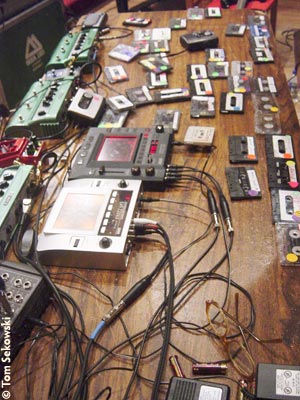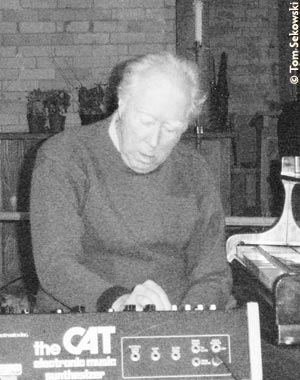
|
| Aki Onda, Alan Licht & Michael Snow |
|
| December 12, 2008 • The Music Gallery • Toronto |
|
|
|
|
|
|
Touching the Dusty Memory Banks of Sound
by Tom Sekowski |
| Not entirely sure what to expect, I stumbled into The Music Gallery on this chilly late autumn night with a sense of the unknown. Questions were popping at me from left and right. Would this trio work? Can three minds coming from different experiences stomp on common ground? Was there reason to believe the sounds they produce in a vacuum would gel with those of the person sitting next to them during the performance?
Before I reveal answers that popped faster than I was able to ask actual questions, a bit of history is ideal. Japanese sound musician Aki Onda first became interested in field recordings during the late 80’s when he bought a Walkman at a market in London. His fascination exploded as he began to document practically everything that had some purpose that was happening around him. A large-scale project called Cassette Memories was born, in which Onda spliced pieces of his extensive documents from tape into a coherent whole. Background sounds, noises, hustle and bustle of city streets and markets in distant lands all made it into the mix. The composer considered these to be his personal memories — sounds that only he could put a picture, date and corresponding visage to.
Alan Licht was apparently so enraptured by Wings (Paul McCartney superband 70’s phenomenon), he decided to take guitar lessons to absorb some of that rock magic. Through the years, he played on both sides of the fence, spending equal time with the lesser-known ‘rock’ crowd — Jandek and Royal Trux — as much as he dwelled on the improvised scene — Keith Rowe, Peter Brotzmann, Rashied Ali — and finally moving on to composed music with people such as Phill Niblock. A few years ago, he formed Text of Light with Lee Ranaldo, where his ensemble improvises music to old, experimental movies.
Canadian pianist and visual artist Michael Snow needs no introduction. Still active with CCMC (which he founded), he is responsible for orchestrating New York Eye and Ear Control sessions in 1964 that helped to jump-start Albert Ayler on the scene. His visual art — photos, sculptures, paintings, video and film — are known around the world. It was Alan Licht who got in touch with Michael Snow during the late 90’s and began a series of duo concerts. A few years later, Licht and Onda began their duo collaboration.
|
|
 |
|

Michael Snow |
|
|
| As with all good things in life, sometimes one has to feel a vibe before a concrete gelling process takes place. Before one can be called a great swimmer, years of practice have to precede the medal ceremonies. The first bit of the concert was just that — a gelling process. During much of the first hour (in which only Onda and Licht took part), the duo tested the waters. They were swimming but at times sounds fell through the cracks. Much of the time, I heard a progression to something greater, but before a build-up was allowed to proceed to a higher plateau, things crumbled from a sonic perspective. Licht was merely teasing the audience’s ears with subtle string caresses. When he did get off the ground and actually increased the intensity by hitting the pedals, the bursts were short-lived. All the while, Onda was trying to react and lead the duo — something that I imagine was quite difficult to achieve. He would load random tapes into his Walkmans and then distort the sound according to his whim. Sure, he would consider what his musical partner was doing at the time, but more often than not, he was faced with miscued tapes. One got the feeling he was flustered too often, which resulted in a lackluster set of music. What should have worked came off as a rehearsal and a testing of the waters for the trio set that came after a short break.
When Michael Snow joined the duo the sparks truly began to fly. Snow lit the fire, his fingers striking the ivories with agility and great speed, while Licht matched this consistency on the strings of his electric guitar. For a few minutes, the duo reacted to Snow’s abrupt changes until he switched over to his analog synth. At this moment, the music took a drastic turn and tripled in intensity. While Snow attacked the keyboard with fervour, Licht glided across the strings with passion and insane skill. Onda had finally hit his stride and the machinations of his processed (sometimes lightly, sometimes not at all) Walkman memories — a variety of nature sounds, harsh noise, surroundings of a market, gongs — added the perfect icing. In many respects, it was Onda setting the pace, but as the piece proceeded one could tell, there was no real leader. The trio was democratic and each member got equal share during the process. Sounds were sparkling, abrasive, wobbly, foreign, untested, mesmerizing, obtuse but most of all alive. It’s collaborations like this one that I live for!
|
|
|
|
|
|



